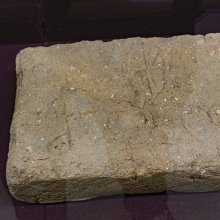Thupa, Thūpa: 3 definitions
Introduction:
Thupa means something in Buddhism, Pali, the history of ancient India. If you want to know the exact meaning, history, etymology or English translation of this term then check out the descriptions on this page. Add your comment or reference to a book if you want to contribute to this summary article.
Images (photo gallery)
India history and geography
Source: Wikipedia: India HistoryThupa is synonymous with Stupa: an outstanding type of architectural creation of ancient Sri Lanka. Under the influence of Buddhism, there were several changes in the field of architecture in Sri Lanka. The stupa commands a prominent place among these changes.

The history of India traces the identification of countries, villages, towns and other regions of India, as well as mythology, zoology, royal dynasties, rulers, tribes, local festivities and traditions and regional languages. Ancient India enjoyed religious freedom and encourages the path of Dharma, a concept common to Buddhism, Hinduism, and Jainism.
Languages of India and abroad
Pali-English dictionary
Source: BuddhaSasana: Concise Pali-English Dictionarythūpa : (m.) a tope; pagoda; a cairn; a monument erected over the ashes of a holy person.
Source: Sutta: The Pali Text Society's Pali-English DictionaryThūpa, (Vedic stūpa, crown of the head, top, gable; cp. Gr. stu/pos (handle, stalk). Oicel. stūfr (stump), to *steud as in tudati) a stupa or tope, a bell-shaped pile of earth, a mound, tumulus, cairn; dome, esp. a monument erected over the ashes of an Arahant (otherwise called dhātugabbha=dāgaba), or on spots consecrated as scenes of his acts. In general as tomb: Vin. IV, 308; J. III, 156 (mattika°)=Pv. I, 84; in special as tope: D. II, 142, 161, 164 sq.; A. I, 77; M. II, 244; J. V, 39 (rajata°); VvA. 156 (Kassapassa bhagavato dvādasayojanikaṃ kanaka°); Ud. 8; Pv III, 105. Four people are thūpârahā, worthy of a tope, viz. a Tathāgata, a Tathāgatasāvaka, a Paccekabuddha, a Cakkavattin D. II, 143= A. II, 245.—At Dpvs VI, 65 th. is to be corrected into dhūpaṃ. (Page 309)

Pali is the language of the Tipiṭaka, which is the sacred canon of Theravāda Buddhism and contains much of the Buddha’s speech. Closeley related to Sanskrit, both languages are used interchangeably between religions.
See also (Relevant definitions)
Starts with (+7): Thuparaha, Thuparaha Sutta, Thuparama, Thuparamavihara, Thuparinu, Thuparnu, Thupasikha, Thupavamsa, Thupavitthi Vihara, Tupaci, Tupakalacam, Tupakatam, Tupakkal, Tupakki, Tupakkinni, Tupakkutam, Tupamani, Tupanam, Tupankattu, Tupankotu.
Ends with: Aintupa, Damilathupa, Dussa Thupa, Ekathupa, Elara-thupa, Jetavana-thupa, Kancanathupa, Khandhaka Thupa, Mahathupa, Maruthupa, Rupavatithupa.
Full-text (+229): Damilathupa, Gambhiranadi, Thuparama, Hemavalika Cetiya, Mahacetiya, Sonnamali, Vivaṇṇeti, Hemamalaka, Jetavana-thupa, Rupavaticetiya, Silasobbhakandaka Cetiya, Manicetiya, Suvannamali, Acala, Ratanavaluka, Maricavatti, Khandhaka Thupa, Sirivadhaka, Kancanathupa, Mahamangala.
Relevant text
Search found 11 books and stories containing Thupa, Thūpa; (plurals include: Thupas, Thūpas). You can also click to the full overview containing English textual excerpts. Below are direct links for the most relevant articles:
Mahavamsa (by Wilhelm Geiger)
Dipavamsa (study) (by Sibani Barman)
Vinaya Pitaka (1): Bhikkhu-vibhanga (the analysis of Monks’ rules) (by I. B. Horner)
Banner of the Arahants (by Bhikkhu Khantipalo)
Vinaya Pitaka (3): Khandhaka (by I. B. Horner)
The story of the excellent group < [1. Going forth (Pabbajjā)]
A Short history of Lanka (by Humphry William Codrington)

